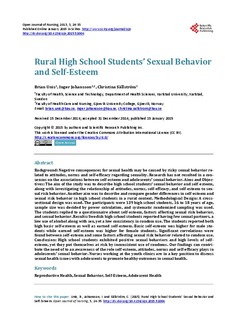| dc.contributor.author | Unis, Brian | |
| dc.contributor.author | Johansson, Inger Signe | |
| dc.contributor.author | Sällström, Christina | |
| dc.date.accessioned | 2015-02-19T08:40:05Z | |
| dc.date.accessioned | 2015-02-20T10:22:47Z | |
| dc.date.available | 2015-02-19T08:40:05Z | |
| dc.date.available | 2015-02-20T10:22:47Z | |
| dc.date.issued | 2015 | |
| dc.identifier.citation | Unis, B., Johansson, I. S. & Sällström, C. (2015) Rural High School Students’ Sexual Behavior and Self-Esteem. In: Open Journal of Nursing, 5(1), p. 24-35. | nb_NO |
| dc.identifier.issn | 2162-5344 | |
| dc.identifier.uri | http://hdl.handle.net/11250/276898 | |
| dc.description | This article is designed as ”Open Access”. This is the journal's PDF originally published in Open Journal of Nursing, http://dx.doi.org/10.4236/ojn.2015.51004 | nb_NO |
| dc.description.abstract | Background: Negative consequences for sexual health may be caused by risky sexual behavior related to attitudes, norms and self-efficacy regarding sexuality. Research has not resulted in a consensus on the associations between self-esteem and adolescents’ sexual behavior. Aims and Objectives: The aim of the study was to describe high school students’ sexual behavior and self-esteem, along with investigating the relationship of attitudes, norms, self-efficacy, and self-esteem to sexual risk behavior. Another aim was to describe and compare gender differences in self-esteem and sexual risk behavior in high school students in a rural context. Methodological Design: A cross-sectional design was used. The participants were 139 high school students, 16 to 18 years of age, sample size was decided by power calculation, and systematic randomized sampling was used. The students replied to a questionnaire about self-esteem, factors affecting sexual risk behavior, and sexual behavior. Results: Swedish high school students reported having few sexual partners, a low use of alcohol along with sex, yet a low consistency in condom use. The students reported both high basic self-esteem as well as earned self-esteem. Basic self-esteem was higher for male students while earned self-esteem was higher for female students. Significant correlations were found between self-esteem and some factors affecting sexual risk behavior related to condom use. Conclusion: High school students exhibited positive sexual behaviors and high levels of self-esteem, yet they put themselves at risk by inconsistent use of condoms. Our findings can contribute the need of to an awareness of the role self-esteem, attitudes, norms and self-efficacy plays in adolescents’ sexual behavior. Nurses working at the youth clinics are in a key position to discuss sexual health issues with adolescents to promote healthy outcomes in sexual health. | nb_NO |
| dc.language.iso | eng | nb_NO |
| dc.publisher | Scientific Research | nb_NO |
| dc.rights | Navngivelse-Ikkekommersiell 3.0 Norge | * |
| dc.subject | reproductive health | nb_NO |
| dc.subject | sexual behavior | nb_NO |
| dc.subject | self-esteem | nb_NO |
| dc.title | Rural High School Students’ Sexual Behavior and Self-Esteem | nb_NO |
| dc.type | Journal article | nb_NO |
| dc.type | Peer reviewed | nb_NO |
| dc.date.updated | 2015-02-19T08:40:05Z | |
| dc.subject.nsi | VDP::Medical disciplines: 700::Health sciences: 800::Community medicine, Social medicine: 801 | nb_NO |
| dc.source.pagenumber | 24-35 | nb_NO |
| dc.source.volume | 5 | nb_NO |
| dc.source.journal | Open Journal of Nursing | nb_NO |
| dc.source.issue | 1 | nb_NO |
| dc.identifier.doi | 10.4236/ojn.2015.51004 | |
| dc.identifier.cristin | 1202440 | |
